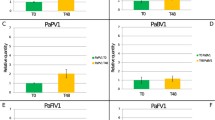Abstract
In culture, Phytophthora fungi — except P. nicotianae — secrete proteins, called elicitins, which cause necrosis on the leaf of the non-host tobacco (Nicotiana tabacum L.) at a distance from the inoculation site, and are responsible for the incompatible reaction. Cryptogein and capsicein are elicitins secreted by P. cryptogea and P. capsici, respectively, and form part of a novel family of 10-kDa holoproteins. On tobacco, the necrotic activity of cryptogein is approx. 100-fold higher than that of capsicein. Using elicitins radioactively labelled in vivo, we have demonstrated that cryptogein and capsicein (i) move from a wound in the stem towards the leaves where they interact directly, (ii) reach their target without undergoing any molecular alteration, (iii) are carried in, and at the same rate as, the sap flow in the xylem, (iv) do not alter the rate of the xylem flow although they are able to provoke drastic damage to the lamina. Consequently, the remote necrotic activity of elicitins does not require any transportable secondary plant elicitor, so the differences in necrotic properties should be due to structural features involved in the interaction of elicitins with the leaf target cells.
Similar content being viewed by others
Abbreviations
- Mr :
-
relative molecular mass
- RPLC:
-
reversephase liquid chromatography
- SDS-PAGE:
-
sodium dodecyl sulfate-polyacrylamide gel electrophoresis
References
Baudet, J., Huet, J.C., Jolivet, E., Lesaint, C., Mossé, J., Pernollet, J.C. (1986) Changes in accumulation of seed nitrogen compounds in maize under conditions of sulphur deficiency. Physiol.Plant. 68, 608–614
Blein, J.P., Milat, M.L., Ricci, P. (1991) Responses of cultured tobacco cells to cryptogein, a proteinaceous elicitor from Phytophthora cryptogea. Plant Physiol. 95, 486–491
Bonnet, P. (1985) Réactions différentielles du tabac à 9 espèces de Phytophthora. Agronomie 5, 801–808
Bonnet, P., Poupet, A., Abad, P., Venard, P., Cardin, L. (1986) Induction de nécroses foliaires, de protéines b et de résistance dans les interactions tabac — Phytophthora. Agronomie 6, 829–837
Bowen, R.M., Heale, J.B. (1987) Four “necrosis-inducing” components, separated from germination fluid of Botrytis cinerea induce active resistance in carrot root tissue. Physiol. Mol. Plant Pathol. 30, 55–66
Cervone, F., Hahn, M.G., De Lorenzo, G., Darvill, A., Albersheim, P. (1989) Host-Pathogen interactions.XXXIII. A plant protein converts a fungal pathogenesis factor into an elicitor of plant defense responses. Plant Physiol. 90, 542–548
Chamberlain, J.P. (1979) Fluorographic detection of radioactivity in polyacrylamide gels with the water-soluble fluor, sodium salicylate. Anal. Biochem. 98, 132–135
Csinos, A., Hendrix, J.W. (1977a) Nonparasitic stunting of tobacco plants by Phytophthora cryptogea. Can. J. Bot. 55, 26–29
Csinos, A., Hendrix, J.W. (1977b) Toxin produced by Phytophthora cryptogea active on excised tobacco leaves. Can. J, Bot. 55, 1156–1162
Csinos, A., Hendrix, J.W. (1978) Phytophthora species producing toxin active on tobacco. Soil Biol. Biochem. 10, 47–51
De Wit, P.G.J.M., Hofman, A.E., Velthuis, G.C.M., Kuc, J.A. (1985) Isolation and characterization of an elicitor of necrosis isolated from intercellular fluids of compatible interactions of Cladosporium fulvum (syn. Fulvia fulva) and tomato. Plant Physiol. 77, 642–647
Dixon, R.A., Lamb, C.J. (1990) Molecular communication in interactions between plants and microbial pathogens. Annu. Rev.Plant Physiol. Plant Mol. Biol. 41, 339–367
Farmer, E.E., Helgeson, J.P. (1987) An extracellular protein from Phytophthora parasitica var. nicotiance is associated with stress metabolite accumulation in tobacco callus. Plant Physiol. 85, 733–740
Huet, J.C., Pernollet, J.C. (1989) Amino acid sequence of cinnamomin, a new member of the elicitin family, and its comparison to cryptogein and capsicein. FEBS Lett. 257, 302–306
Huet, J.C., Sallantin, M., Pernollet, J.C. (1990) Large scale purification of elicitins, protein elicitors secreted by the plant pathogenic fungi Phytophthora. In: Technologies de purification des protéines, vol. 4, pp. 29–34, Briand, Y., Doinel, C., Faure, A., eds, G.R.B.P., Villebon/Yvette, France
Lamb, C.J., Lawton, M.A., Dron, M., Dixon, R.A. (1989) Signals and transduction mechanisms for activation of plant defenses against microbial attack. Cell 56, 215–224
Nespoulous, C., Huet, J.C., Pernollet, J.C. (1992) Structure-function relationships of α and β elicitins, signal proteins involved in the plant-Phytophthora interaction. Planta, 186, 551–557
Parker, J.E., Hahlbrock, K., Scheel, D. (1988) Different cell-wall components from Phytophthora megasperma f. sp. glycinea elicit phytoalexin production in soybean and parsley. Planta 176, 75–82
Plich, M., Rudnicki, R.M. (1979) Studies of the toxins of Phytophthora cactorum pathogenic to apple trees. I. Isolation, some of the properties and activities of a toxin produced by the fungus cultured in vitro. Phytopath. Z. 94, 270–278
Ricci, P., Bonnet, P., Huet, J.C., Sallantin, M., Beauvais-Cante, F., Bruneteau, M., Billard, V., Michel, G., Pernollet, J.C. (1989) Structure and activity of proteins from pathogenic fungi Phytophthora eliciting necrosis and acquired resistance in tobacco. Eur. J. Biochem. 183, 555–563
Sallantin, M., Huet, J.C., Demarteau, C., Pernollet, J.C. (1990) Reassessment of commercially available molecular weight standards for peptide sodium dodecyl sulfate-polyacrylamide gel electrophoresis using electroblotting and microsequencing. Electrophoresis 11, 34–36
Sperry, J.S., Tyree, M.T. (1988) Mechanism of water stress-induced xylem embolism. Plant Physiol. 88, 581–587
Tyree, M.T., Sperry, J.S. (1989) Vulnerability of xylem to cavitation and embolism. Annu. Rev. Plant Physiol. Mol. Biol. 40, 19–38
Author information
Authors and Affiliations
Additional information
The authors are indebted to Mauricette Sallé-Tourné, Marc Sallantin and Christian Ouali for their skilful technical assistance.
Rights and permissions
About this article
Cite this article
Zanetti, A., Beauvais, F., Huet, JC. et al. Movement of elicitins, necrosis-inducing proteins secreted by Phytophthora sp., in tobacco. Planta 187, 163–170 (1992). https://doi.org/10.1007/BF00201933
Accepted:
Issue Date:
DOI: https://doi.org/10.1007/BF00201933




